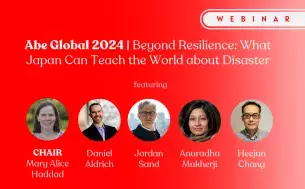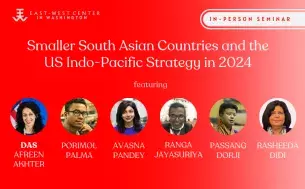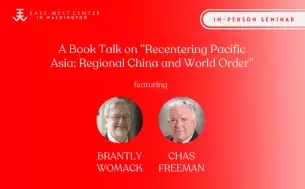Error message
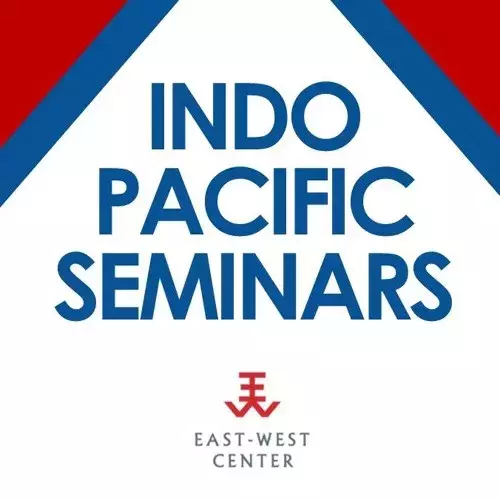
OFFICE/DEPARTMENT
The Indo-Pacific Strategy & Opportunities for US-Japan Energy Collaboration
An Indo-Pacific Political Economy and Trade Seminar featuring:
Ms. Courtney Weatherby
Visiting Fellow,
U.S.-Japan-Southeast Asia Partnership in a Dynamic Asia Fellowship,
East-West Center in Washington
Dr. Satu Limaye (Moderator)
Director, East-West Center in Washington
Southeast Asia faces a $2.6 trillion energy and infrastructure investment gap through 2040. China’s Belt and Road Initiative is the headline response to these needs, but concerns over the economic viability, and social and environmental impacts from
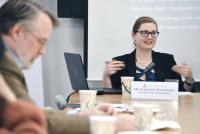
BRI projects have prompted the U.S to re-evaluate its own infrastructure and development finance strategies under the Indo-Pacific Strategy. No individual country is capable of single-handedly filling the infrastructure gap, so in order for the BUILD Act and emerging economic initiatives in the Indo-Pacific to be successful, the United States will need to coordinate closely with allies and partners. Japan is a long-time investor in infrastructure in Southeast Asia, and there are obvious complementarities between the US IPS and Japan’s own Quality Infrastructure Initiative. In this seminar, Courtney Weatherby explored successes and challenges in operationalizing the U.S-Japan partnership on infrastructure in third countries and discussed some potential areas for coordination in Southeast Asia.
This seminar was part of a series tied to the U.S.-Japan-Southeast Asia in a Dynamic Asia Fellowship program jointly organized and sponsored by the East West Center and Osaka University’s Osaka School of International Public Policy (OSIPP). Generously funded by The Japan Foundation and US Embassy Tokyo, this fellowship has brought together two American, two Japanese, and two Southeast Asian fellows for three months to explore the following theme: How should the United States, Japan, and Southeast Asia collaborate on trade, investment, and economic integration in Southeast Asia?
For more images, please visit the album for this event on the East-West Center's Flickr page.
Courtney Weatherby is currently a Visiting Fellow with the East-West Center in Washington, doing research on obstacles to and opportunities for US – Japan collaboration on energy infrastructure in Southeast Asia. She is also a Research Analyst with the Stimson Center’s Southeast Asia and Energy and Water, & Sustainability programs, where she focuses on sustainable infrastructure development, regional geopolitics, and energy challenges, particularly food-water-energy issues in the Mekong basin. Weatherby was the lead author on the Stimson Center’s Mekong Power Shift report and the TRENDS Institution UAE Energy Diplomacy report, and wrote a chapter “China Invests in Myanmar: The Political Fallout of ‘Going Out’ Next Door” in the 2014 book China’s Great Leap Outward. She has also authored and co-authored numerous short pieces a range of online publications including East by Southeast, The Bangkok Post, Nikkei Asian Review, and the Diplomat. Before joining Stimson in 2014, Weatherby briefly worked with the Center for Strategic International Studies, the State Department, and Human Rights Watch. She holds a M.A. in Asian Studies from the School of Foreign Service at Georgetown University and a B.A. in East Asian Studies with honors from Dickinson College.
Satu Limaye is the Director of the East-West Center in Washington where he created and now directs the Asia Matters for America initiative and edits the Asia Pacific Bulletin. He is also a Senior Advisor at CNA Corp (Center for Naval Analyses) and Senior Fellow on Asia History and Policy at the Foreign Policy Institute at Paul H. Nitze School of International Studies (SAIS). He is a magna cum laude and Phi Beta Kappa graduate of Georgetown University and received his doctorate from Oxford University (Magdalen College) where he was a George C. Marshall Scholar. Dr. Limaye publishes and presents on a range of Indo-Pacific issues. Recent publications include: The Indian Ocean in Japan’s Free and Open Indo-Pacific Policies (forthcoming); Russia's Peripheral Relevance to US-Indo Pacific Relations (forthcoming); Why ASEAN is Here to Stay and What that Means for the US; America’s 2016 Election Debate on Asia Policy and Asian Reactions (with Robert Sutter); The United States-Japan Alliance and Southeast Asia: Meeting Regional Demands; and Weighted West: The Indian Navy’s New Maritime Strategy, Capabilities, and Diplomacy.
The Indo-Pacific Strategy & Opportunities for US-Japan Energy Collaboration
An Indo-Pacific Political Economy and Trade Seminar featuring:
Ms. Courtney Weatherby
Visiting Fellow,
U.S.-Japan-Southeast Asia Partnership in a Dynamic Asia Fellowship,
East-West Center in Washington
Dr. Satu Limaye (Moderator)
Director, East-West Center in Washington
Southeast Asia faces a $2.6 trillion energy and infrastructure investment gap through 2040. China’s Belt and Road Initiative is the headline response to these needs, but concerns over the economic viability, and social and environmental impacts from

BRI projects have prompted the U.S to re-evaluate its own infrastructure and development finance strategies under the Indo-Pacific Strategy. No individual country is capable of single-handedly filling the infrastructure gap, so in order for the BUILD Act and emerging economic initiatives in the Indo-Pacific to be successful, the United States will need to coordinate closely with allies and partners. Japan is a long-time investor in infrastructure in Southeast Asia, and there are obvious complementarities between the US IPS and Japan’s own Quality Infrastructure Initiative. In this seminar, Courtney Weatherby explored successes and challenges in operationalizing the U.S-Japan partnership on infrastructure in third countries and discussed some potential areas for coordination in Southeast Asia.
This seminar was part of a series tied to the U.S.-Japan-Southeast Asia in a Dynamic Asia Fellowship program jointly organized and sponsored by the East West Center and Osaka University’s Osaka School of International Public Policy (OSIPP). Generously funded by The Japan Foundation and US Embassy Tokyo, this fellowship has brought together two American, two Japanese, and two Southeast Asian fellows for three months to explore the following theme: How should the United States, Japan, and Southeast Asia collaborate on trade, investment, and economic integration in Southeast Asia?
For more images, please visit the album for this event on the East-West Center's Flickr page.
Courtney Weatherby is currently a Visiting Fellow with the East-West Center in Washington, doing research on obstacles to and opportunities for US – Japan collaboration on energy infrastructure in Southeast Asia. She is also a Research Analyst with the Stimson Center’s Southeast Asia and Energy and Water, & Sustainability programs, where she focuses on sustainable infrastructure development, regional geopolitics, and energy challenges, particularly food-water-energy issues in the Mekong basin. Weatherby was the lead author on the Stimson Center’s Mekong Power Shift report and the TRENDS Institution UAE Energy Diplomacy report, and wrote a chapter “China Invests in Myanmar: The Political Fallout of ‘Going Out’ Next Door” in the 2014 book China’s Great Leap Outward. She has also authored and co-authored numerous short pieces a range of online publications including East by Southeast, The Bangkok Post, Nikkei Asian Review, and the Diplomat. Before joining Stimson in 2014, Weatherby briefly worked with the Center for Strategic International Studies, the State Department, and Human Rights Watch. She holds a M.A. in Asian Studies from the School of Foreign Service at Georgetown University and a B.A. in East Asian Studies with honors from Dickinson College.
Satu Limaye is the Director of the East-West Center in Washington where he created and now directs the Asia Matters for America initiative and edits the Asia Pacific Bulletin. He is also a Senior Advisor at CNA Corp (Center for Naval Analyses) and Senior Fellow on Asia History and Policy at the Foreign Policy Institute at Paul H. Nitze School of International Studies (SAIS). He is a magna cum laude and Phi Beta Kappa graduate of Georgetown University and received his doctorate from Oxford University (Magdalen College) where he was a George C. Marshall Scholar. Dr. Limaye publishes and presents on a range of Indo-Pacific issues. Recent publications include: The Indian Ocean in Japan’s Free and Open Indo-Pacific Policies (forthcoming); Russia's Peripheral Relevance to US-Indo Pacific Relations (forthcoming); Why ASEAN is Here to Stay and What that Means for the US; America’s 2016 Election Debate on Asia Policy and Asian Reactions (with Robert Sutter); The United States-Japan Alliance and Southeast Asia: Meeting Regional Demands; and Weighted West: The Indian Navy’s New Maritime Strategy, Capabilities, and Diplomacy.







